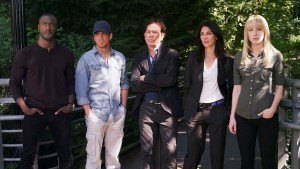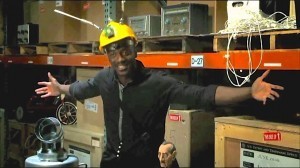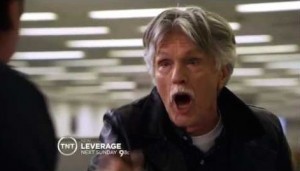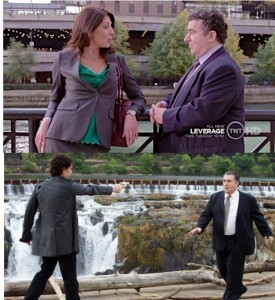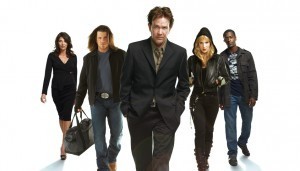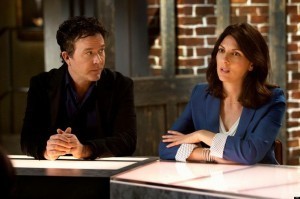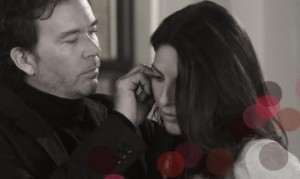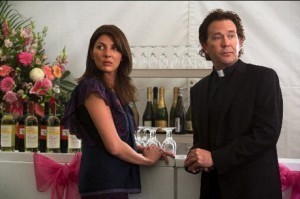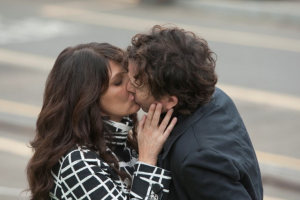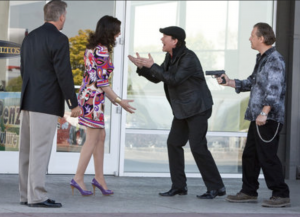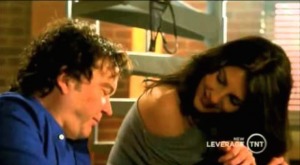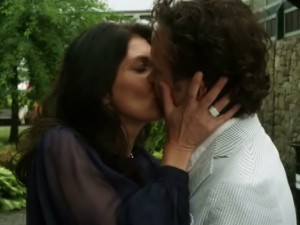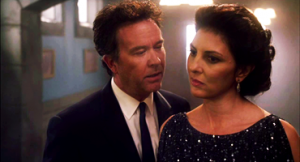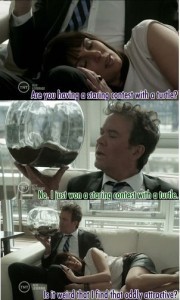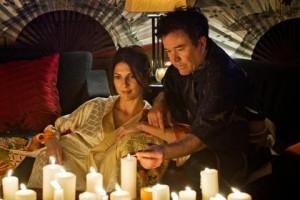Jennifer Crusie's Blog, page 266
June 25, 2014
Questionable: Opening Scenes
Beth said:
I had a question about beginnings. For first draft I do the don’t look down brainspew method, but then, once you think you know the story, what are some tips to go back and craft a really great opening scene?
Write the whole book first. Then go back and revise the opening scene so that it introduces the story. The beginning is the promise you make the reader. It sets the tone, introduces the protagonist and the conflict, and starts the action. But until you finish the book, you don’t really know what you’re introducing. You can’t introduce a person you’ve never met and you can’t introduce a book you haven’t finished. This is especially true if you’re going for a powerful bookending beginning/ending, setting up the beginning so that it echoes the climax or resolution, creating the sense that the book has come full circle from stability to stability. So finish the book and then invite people into the party you’ve written for them.
That’s good advice but nobody, including me, ever follows it, so I think you just have to resign yourself to the fact that although you will be driven to rewrite that first scene, no matter how many times you do it, you’ll still rewrite at least one more time when the first draft is finished. Because that’s when you’ll know what your story is about.

June 24, 2014
Questionable: Thinking in Story
Kelly wrote:
I have a question – how do [you] learn to think in story? . . . . So far, I’ve started a dozen stories that have fizzled out from lack of creative fuel. Any advice for learning to invent and develop characters and stories? Thank you!
Some people are natural storytellers. (Hi, Krissie.) Some people are not. (That would be me.) Those of you who are natural storytellers should go somewhere else now because the stuff in this post is just going to screw you up. For the rest of us, here are some coping strategies:
1. Your first draft is your don’t-look-down Good Parts draft. That is, you write all the fun stuff without worrying about whether it makes sense. It doesn’t have to be in chronological order. Names can change. You can write sex scenes that would make a hooker blush or just write “sex scene here” and move on. You can do anything you want, as long as it’s your people doing things on the page. They do have to keep moving, they can’t just sit and think or do too much sittin’ and talkin’, keep those bodies in motion because character is action.
2. At some point you will start to panic because your draft is all over the place. Telling yourself that it’s okay, that it’s a first draft, that it’s supposed to be all over the place, will only work for so long. So that’s when you start building yourself a net. And the basis of the net is
Protagonist (goal) vs. Antagonist (goal)
or if you prefer your plot stated as a question:
Will the protagonist defeat the antagonist and get his or her goal?
If you’re like me, you’ll be able to identify your protagonist. The rest is a mystery. So you move onto . . .
3. Look at what you have written and figure out what the protagonist wants. This has to be a positive, concrete goal. It can’t be world peace or inner peace or love or revenge, it has to be defusing the bomb, or building a temple, or having a big wedding, or filling somebody’s car with shrimp. It has to be something that the protagonist will have to move her body to get. If the goal is that she doesn’t want to love again because she’s been hurt before, you’re screwed because that’s a negative goal. A positive goal is something she wants, not something she’s saying no to. A positive goal is something she’ll move out of her comfort zone to get, cross personal boundaries to achieve, kill to possess. A positive goal keeps a protagonist saying, “Yes” and moving fast; a negative goal keeps a protagonist saying, “No,” and freezes her in place (boring and annoying). Figure out what the protagonist’s positive goal is, and you’re halfway home.
4. Okay, you have a protagonist and a goal. Now why can’t she get it? What and, more importantly, who is standing in her way? That character is the antagonist, and once you have him or her identified, then you do the same goal hunt that you did for the protagonist. The antagonist’s goal can be the same as the protagonist’s–they both want the Ark of the Covenant–or they can be completely different, the only things that are necessary is that the characters MUST have these goals or they’ll die (physically or emotionally) and these goals must bring them into direct conflict: only one can win and the other will then be defeated utterly and destroyed. (The conflict box is a BIG help here.)
5. Now go back and rewrite what you have to shape your narrative so that it’s a battle between your protagonist and antagonist, raising the stakes as they both cross boundaries, and speeding up the pacing as they race toward their final battle. Then keep writing the new scenes you need and revising and writing and revising and writing and revising . . .
That’s basic, classic linear structure. There are a million other structures you can use so this one may not be yours, but the vast majority of print and film stories are linear.
After that it’s just a long, hard slog through a million revisions, holding onto that central story idea. Good luck!

June 22, 2014
Leverage Sunday: “The Radio Job” & “The Last Dam Job”: Endings
Here’s the problem with writing a series, any kind of series: every time you end a book or a season, you create a turning point, a culmination of that story. If you keep creating turning points, eventually the reader subconsciously starts to think, “Are we there yet?” And if you create an turning point that answers all questions and leaves all the characters in a place of strength and stability, you’re done. Anything you write after that will be epilogue, the stuff that happens after the story is over. Some series manage to avoid that trap by stopping after that satisfying ending (Life on Mars was brilliant at this); some keep going and slowly run out of steam (The Mentalist ended when Jane killed the Bradley Whitford Red John; everything after that felt like milking a premise to earn money). Leverage managed to makes its epilogue season–Season Five–entertaining still, but much of that was because they evolved the team into something else. Season Four was the last act of the Leverage team in the sense that this is the season that brought them to stability, security, and happiness as a team.
“The Radio Job” starts with Nate leaving the team to break into the Patents Office Building, which works about as well as you’d expect. The team finds him before he gets in the door. What’s he going in for? To get his father out.
The team is less than thrilled since Jimmy Ford is kind of a bastard, but Nate needs them, so they pull off the theft and an escape from the cops and Homeland Security, only to have Jimmy take the MacGuffin and go off to meet the bad guys in an abandoned warehouse, where he’s killed in an explosion, part of the payback from Victor Dubenich, the very first Big Bad from the pilot.
One of the most effective ways to create a feeling of closure is to bookend your beginning and ending. Repeat locations, repeat situations, repeat phrases of dialogue, repeat anything that will create a call-back in the reader or viewer’s mind, the sense that this conclusion was inevitable, the seeds planted from the beginning. The ending of “The Radio Job” and the entirety of the “The Last Dam Job” are brilliant at creating this sense of closure, which is wonderful for the episode (not so great for a series that has another season to run).
It’s in “The Last Dam Job” that Leverage really attains the height of its five seasons. The team is up against not only a man who knows their individual strengths since he’s the one who put four of them together in the first place, it’s fighting a man who’s been nursing a grudge for over three years, watching their every move, studying them so that he knows exactly what they’ll do next. He has them boxed in because he knows them so well, so the team brings in their doppelgängers, friends and enemies Victor doesn’t know at all, and by double-teaming him defeats him brilliantly and utterly.
That by itself would make “The Last Dam Job” a wonderful finale, but even more powerful is the way it nails the arc of the community. From five people who were loners, only agreeing to a one-time job, to a team that is so tight that when Nate faces down his father’s killers intending to execute them, the other four are with him, watching him, not interfering but by their very presence letting him know that he’s more than that because he’s part of them. When Nate puts down the gun and walks, he’s not walking away from the bad guys, he’s walking toward the family he belongs with and can’t let down. The team in this scene is like a great frame: their presence takes a simple adventure scene and transforms it into character crisis and epiphany. And when Nate, the team member most distant from the others, chooses to join them, the community arc is complete, too. Nothing can destroy that team now.
It’s a brilliant finale, but it set up some real problems for Season Five. I think the way the Leverage writers addressed those problems was the smartest path to take, but any path was going to be tricky because the community arc is over. Now what are you going to do?
Well, you can complete individual characters arcs, set up the greatest job of the team’s career, and then have them recognize where their futures lie and part company, still a family, just not a team. For those of us who loved the team, it’s a problematical season, but for those of us who loved the tricky plots and the fascinating characters, it’s still must-see TV.
Next week, Parker’s arc is completed when she’s once again working alone in “The Broken Wing Job.” The week after that, the beginnings of the end as the team splits into the younger three taking on terrorism (“The Rundown Job”), and Sophie and Nate solving a mystery as a virtually-married couple ala Nick and Nora Charles (“The Frame-Up Job”). And then finally, the real series finale, “The Long Goodbye Job,” which I have serious issues with, and summing up the series, which I do not have serious issues with because it’s in my Top Five TV Series of All Time.

June 21, 2014
Cherry Saturday 6-21-14
Hey, it’s SUMMER. I mean, OFFICIALLY. Take the day off. Hell, take a week off, it’s SUMMER.

June 20, 2014
Questionable: Emotional Wounds, Then and Now
S asked:
Can we hear more about the hero’s wound, the emotional arc and character growth. Is the wound always an emotional wound? Do we have to give the hero a wound? Are they all the same thing? And what is the expectation in romance, with regard to these concepts, in comparison to other kinds of novels? What’s the difference between emotional arc over a scene, compared to emotional arc over the length of the book? Someone told me that the emotional arc over the book is the wound being healed. In a scene, I’ve been told that there are pretty much 2 ways to drive emotional arc/ change, and that’s from conflict (inner or outer) or by the character remembering a powerful event. And the latter is to be used sparingly. Do you agree with the 2 ways? I’ve read about the conflict box (first heard about it when you and Bob discussed it online). It was about goals and obstacles. How do I put the wound/emotional arc in the conflict box too? Would that be OTT?
I’m not a fan of the emotional-wound approach to characterization, aka the something-nasty-in-the-woodshed back story device. We all start with the emotional wound of birth–remember how nice it was in the womb?–and then there’s the cold world and a lot of people saying “No” and then they make you go to school where that bitch Barbara makes fun of you in the first grade, and then before you know it, you’re in junior high which is just one humiliation after another, and then you graduate and, fuck, you’re supposed to make a living, and your boss tells you that you’re a loser, and the person you’ve fallen head over heels for rips your heart out and feeds it to the cat, and then . . . .
Life is a series of ongoing emotional wounds. The idea that there was One Big Thing that put a hole in the heart of the character is just too reductive. Human beings in the womb have nice smooth surfaces, and then here come the forceps and after that it’s just one scratch and dent after another, but it’s also one pat and kiss after another, and those count, too. The truth is, your characters are formed by everything they experience, everything they learn, along with everything in that genetic gift bag they were born with.
AND ALL OF THAT HAPPENS BEFORE THE STORY STARTS.
Sorry about the all caps, but one of the biggest story killers is back story, and the worst of all back story weight is the Big Bad Thing that the protagonist lugs around with him or her like a backpack full of bottled water. Even worse is the Universal Emotional Wound. “He became a serial killer because he was abused as a child.” That’s it, that’s the whole reason. Sure other people were abused and became therapists and snipers and Whole Foods managers, but all you need to know to understand this serial killer is a history of child abuse. No. I don’t give a damn about the past, what I want to know is what this character is getting out of offing people as a hobby NOW.
So In My Humble Opinion, all fixating on an emotional wound does is focus a writer’s attention on back story. And we all know how I feel about back story (see multiple previous rants).
Now here’s your question again, this time without the emotional wound, broken down into its parts:
What is the expectation in romance, with regard to these concepts, in comparison to other kinds of novels?
Genre is about marketing, not form. A romance novel is a love story with an optimistic ending, but beyond that, it’s written like any other novel. The vast majority of romance novels are written with classic linear structure, but that doesn’t mean they all are. Probably ninety per cent of them are written in third person limited, but they all aren’t. You can do pretty much anything you like as long as you deliver a compelling story about fascinating people who fall in love and struggle to form and maintain a permanent relationship, aka, a love story with an optimistic ending.
What’s the difference between emotional arc over a scene, compared to emotional arc over the length of the book? . . . . In a scene, I’ve been told that there are pretty much 2 ways to drive emotional arc/ change, and that’s from conflict (inner or outer) or by the character remembering a powerful event. And the latter is to be used sparingly. Do you agree with the 2 ways?
Emotional arc is the change in character that happens over the course of the story because of the actions in the story, the things that happen that hurt the character enough that he or she is forced to change to survive/beat the antagonist/save the farm/whatever. Think of the story as a struggle, a battle, and the scenes as a series of blows (or emotional wounds in the now, if you want, although “wound” seems like overkill). Each scene is a step in the emotional arc. So a character may move from bitterness to acceptance, but he or she does it one step at a time, one scene at a time. Some scenes have harsher conflict and therefore more character growth, but most are incremental changes. One easy way to gauge emotional arc is to look at the character at the beginning of a scene and compare that to the character he or she is at the end of the scene. The change may be very small, but there should be a change. If the character is exactly the same person at the end of the scene, then nothing important happened in the scene and you can cut it.
You can also think of character change as crossing boundaries. In the beginning, your character has a set of rules by which he or she lives life (we all do). But under pressure by the antagonist, scene by scene, she starts moving that boundary line, until by the end, she’s pushed her boundary far past anything she could have imagined at the beginning. And here’s the thing about boundaries: once people move them, they never move them back. They can’t, moving the boundary changed them. The key is that the reason they move boundaries is the events in the now of the story, so that the reader watches them change, understands why they change, experiences the pain of the change with them, all in the now of the story.
Remembering an emotional event changes nothing; if the event was going to change the character, it would have done it when it happened, so sittin’ and thinkin’ about it in the now of the story is just a drag on the pacing. Sometimes something happens in the now of the story to put that past event in a new light, but what changes the character is not what happened in the past but what he or she realizes in the present. Just find a way to make that clear without the deadly character-sitting-alone-thinking-about-the-past-and-having-a-eureka-moment. Sittin’ and thinking’ kills story.
I’ve read about the conflict box (first heard about it when you and Bob discussed it online). It was about goals and obstacles.
Short review of conflict box adapted from Michael Hauge is here. There’s no place for emotional wounds unless you want to add another column for motivation, but again, stay out of back story. The reason the character has a goal NOW is because something is happening NOW, not because there was something nasty in the woodshed thirty years ago.
To sum up:
Any time you hear somebody say, “You need to have this element to make a story work,” somebody is trying to shorthand an incredibly complex task (writing a novel). Even the conflict box is an attempt to simplify the enormously layered relationship at the heart of the story (protagonist vs. antagonist). The emotional wound approach is one way to explore a character, but it’s only one way, and if used by itself, it dumbs down characterization to cartoon-like flatness. Beyond that, some characters don’t have emotional wounds. Sometimes they’re mentally healthy, happy people who cross paths with and are thwarted by other mentally healthy, happy people, and the ensuing struggle during the story inflicts emotional wounds on them and makes them grow. Emotional wounds acquired during the story are much more interesting because we’re seeing them inflicted and we’re seeing how they change the character. Why put the most important thing to ever happen to the character, the thing that changes him or her irrevocably, in the back story? It makes no sense.
So throw rocks at your protagonist in the present on the page in front of the reader, and make sure they connect with some place on him or her that hurts enough that he or she changes in front of the reader. That makes for compelling story and layered character.
Standard Disclaimer: There are many roads to Oz. While this is my opinion on this writing topic, it is by no means a rule, a requirement, or The Only Way To Do This. Your story is your story, and you can write it any way you please.

June 19, 2014
Questionable: Reasons for Rejection
Julie asked:
How about your Top 10 lists of helpful tips like… Top 10 most common things that get a manuscript rejected . . . 10 Rejection Reasons and what they *really* mean (decoding those rejection letters can be hard sometimes).
Top Ten Reasons an Editor Rejects Your Book:
1. She doesn’t know how to sell it to readers.
2. She doesn’t know how to sell it to readers.
3. She doesn’t know how to sell it to readers.
4. She doesn’t know how to sell it to readers.
5. She doesn’t know how to sell it to readers.
6. She doesn’t know how to sell it to readers.
7. She doesn’t know how to sell it to readers.
8. She doesn’t know how to sell it to readers.
9. She doesn’t know how to sell it to readers.
10. She doesn’t know how to sell it to readers.
The bottom line: if she doesn’t think readers will buy your book, she won’t buy it.
Of the course the reasons she thinks readers won’t by the book are endless, and often depend on her subjective viewpoint. That’s why some of the most popular books of all time were rejected by a lot of editors. They weren’t wrong, they really didn’t know how to sell the book. Then one editor looked at it, saw how to sell it to a lot of readers, and went for it.
So some common reasons an editor doesn’t think she can sell a book:
1. The beginning is blah. There’s a prologue, or it starts with the protagonist staring out a window thinking about her life, or it starts with chat as the protagonist and her friend/sister/mother/lawyer discuss her life without conflict, or she’s in trouble but not in conflict, or . . . The beginning is blah and any reader who picks it up in the store or reads the sample online is going to say “Blah.” (Do not tell me it gets really good later. Nobody cares because nobody’s going to read it long enough to get to later. It has to be great on the first page.)
2. The protagonist isn’t someone a reader wants to spend time with. This does not mean the protagonist has to be likable, he can be a complete son of a bitch, but he has to be fascinating and it helps if he or she is also vulnerable and sympathetic so that the reader can connect to him or her. Macbeth is a good man tempted at the beginning of his play, a sympathetic human being; his descent into monstrous madness is therefore horrifying and fascinating. The protagonist of A Few Good Men is an arrogant, immature lawyer who takes the easy way out, but he’s really smart and really skilled and we can’t take our eyes off him (competence porn). That sympathy depends a lot upon genre expectations. I had a student once who was an extremely good writer, but her protagonist was a drug dealer. I told her if she was writing literary fiction or gritty noir, she’d be fine, but in romance, a heroine who preys on addicts for money was going to be a tough sell. That’s the kind of book that gets rejected even if the writing is brilliant because nobody wants to spend time with that protagonist in that kind of story.
3. The plot is a string of pearls. The protagonist tries this and it doesn’t work, so she goes back to where she started and tries this and it doesn’t work, so she goes back to where she started . . . Plots have to escalate, tension has to rise, conflict has to intensify, or the reader gets bored.
4. The story’s been done a million times, and this version has nothing new in it. Every story’s been done before; the key is to write your version so it’s the best version ever, bringing new insight to the tropes, adding new layers. If the editor has seen the premise and the treatment before, she’s not going to be interested. Make it new.
5. The writing is flat, or there’s a good voice there but it’s buried under back story, explanation, and description so that reading the story is a slog rather than a trip. Once a reader (or editor) starts to skim the big blocks of print looking for your story, you’re toast.
But really, the rejection is because the editor didn’t think she could sell the book to readers. If she buys a book that doesn’t sell, she loses her job or at least any promotions in the offing. If she buys a bestseller, her career takes off. So she buys books she thinks will sell. That’s why one of the most effective things you can do, after writing a splendid book that begins with conflict on the first page, is put a short paragraph in your query letter that sells your book in an original and exciting way that the editor can use to sell the book to the editorial board, to bookstore owners, and then to the reader. Show her how to sell your good book, and if she buys your sales pitch, she’ll buy your book (if she thinks it’s good).
Publishing is a business. It’s not art (although there’s an art to doing it well); it’s not personal; it’s not a vile, evil empire out to crush your hopes and dreams; it’s just a business that wants to sell something and make a lot of money. If the people who work in this business think they can make money with your book, they’ll buy it. That’s pretty much all you need to know about acceptance and rejection in publishing.
Standard Disclaimer: There are many roads to Oz. While this is my opinion on this writing topic, it is by no means a rule, a requirement, or The Only Way To Do This. Your story is your story, and you can write it any way you please.

June 17, 2014
Questionable: Managing Writing Time
Cate M asked:
In the real life category, how do you multitask productively when half the tasks are a day job you want to advance in, and half the tasks are story tasks, plus the work that should but is realistically never going to happen, i.e., the ironing basket? You seem to do a lot of multitasking.
Multi-tasking means doing several things at once and it’s a bad, bad, bad idea for writing because it fragments your focus. Better is to figure out what you have to do, the time you have to do it, and make a realistic schedule to follow, one thing at a time. So . . .
1. Make a list of what you want to accomplish each day, each week, etc.
2. Estimate realistically how long it takes you to do each thing. Round up.
3. Find out how many hours your daily to-do list will take. Notice that it’s more than twenty-four hours so that even if you didn’t eat or sleep, you still couldn’t do all of that in one day.
4. Now put the tasks on that list in order of importance, the most important at the top. Be realistic and be savage about what really is important to you, not what you think should be important to you.
5. You have sixteen hours in a day (because you’re sleeping eight hours, and no, you can’t get by on less that that, stop punishing your brain and body because you think you’re SuperGuy or SuperGirl, you’re a human being not a robot). Add up the times on the list and when you get to ten or twelve, draw a line under the last one. (Where do the extra four hours go? Traffic, doctor’s appointments, school plays . . .)
6. Delete everything else from the list. You can’t do those things, you don’t have enough time, and they’re not super-important to you anyway. Stop trying to put twenty pounds of activity into a five-pound day. It wastes your time and annoys the day.
Generally speaking (and I do mean “generally”) most working-an-outside-job and/or raising-children people who really want to write can spare half an hour to an hour a day to write. That’s about it. If you live alone and you don’t care that your house looks like a landfill (that would be my house) you have more time, but the combination of work and family means that it’s really tough. Maybe you only get half an hour a day. Maybe some days–doctor’s appointments, school plays, houseguests–you don’t get that.
The key is: That’s okay. This is your life, right now. Organize it, definitely, but organize it so that you’re not suffering, so that things get done without rushing around and without guilt, and if they don’t get done, well, hell, that happens. Tomorrow is another day. Get rid of everything that isn’t essential, tick the tasks off your To Do list, and stop feeling guilty. Guilt is a real creativity killer, not to mention a savage assault on the quality of your life.
Also don’t forget to dance around the house singing into a salt shaker like a microphone at least once a day. It’s done wonders for me.

June 15, 2014
Leverage Sunday: “The Lonely Hearts Job” Romance & Community
By the end of Season Four, the Leverage team has become a well-oiled machine, trusting each other without reserve and completely invested in the group as a permanent unit. This makes the team fun to watch, but difficult to write good stories about. They’re strong, they’re united, they’re secure when they’re with each other . . . they have no conflict. More than that, they can pretty much take out anybody who comes up against them. This is a group that has stolen a country. They have arch-criminals for breakfast. They’re legendary. So where is the story tension going to come from?
Within any large group there are smaller relationships as each member works out how he or she relates to individual members of the group. The Leverage stories have done a terrific job of evolving those relationships. Some of them have mimicked family relationships: the three youngest members have related to Nate as a father figure throughout, disappointed in his weaknesses, trusting that he’ll get them all out in the end. They’ve also cast Sophie as the mother figure because, as Hardison tells her once, they trust her to keep them safe. And they’ve also reacted to each other as siblings, teasing and fighting in the lighter moments, fiercely defending each other in times of trouble, the “nobody-hits-my-brother-but-me” trope in action (or as Eliot put it, “Nobody throws Hardison off a building. Except me.”)
But they’ve also broken the family parallels. Hardison fell for Parker pretty much from the first episode and their romance arced over four seasons as Parker finally evolved into a person who could feel emotion and attach. Eliot and Parker have an understanding that they can’t share with the others because they can do the things the others can’t; because they’re broken in places that can’t be repaired, they’re more ruthless, and because they’re the physical members of a team that runs on brains and guile, they’re the people who determine how a job is going to be physically executed. Sophie and Parker have a mentor/pupil relationship because Parker needs someone to tutor her on how to be a human being. Nate and Eliot have a partnership, a meeting of two practical, intelligent minds. And Hardison has clearly become the son Nate lost as Nate mentors him into the world of masterminding cons. The pleasure of the team is in how beautifully they function as a whole, but the richness of the team is in how they relate to each other one-on-one.
And then there’s the Nate/Sophie romance.
The key to romance writing is in arcing the emotional growth of the lovers. The he’s-hot-she’s-hot-they-have-great-sex approach doesn’t convince anybody that two people are truly in love. In lust, yes; infatuated with each other, yes; in love for the long haul? Nope. To sell that to readers and viewers, you have to work outside courtship tropes to show who your lovers really are–their fears, their flaws, their needs–and how they grow together, shift their lives to accommodate each other, and come to love each other unconditionally, not because the other provides something they want or admire, but just because they love the other person.
Nate and Sophie’s romance has been simmering for four seasons at this point in the series. There’s good reason why they don’t act on their evident sexual attraction for each other in the pilot: they’re on the job, Sophie’s a crook, and Nate’s an honest man. That dynamic carries them through Season One, and one of the smartest things the writers do with that relationship is show why they don’t connect physically as they show how they’re slowly connecting emotionally. Yes, they’re attracted to each other, but more than that, they grow to care about each other as people. Nate escalates “The Bank Shot Job” because he won’t leave Sophie in the bank when he realizes it’s going to be robbed, even though Sophie is entirely capable of getting herself out. It’s not that he doesn’t think she can save herself, it’s that he can’t leave her.
Sophie struggles with his inability to define their relationship in “The Wedding Job,” then tries to help him as he falls deeper into alcoholism in “The 12-Step Job,” and finally realizes that she has as many issues as he does when she cons the team in “The First David Job” and Nate grimly takes her to task. They both have a lot of growing up to do, a lot of issues to put to rest, and any future relationship is going to rest on their ability to take care of those things first, while maintaining a steady presence for the team. They’re the symbolic parents of Leverage, and if they’re not rock solid, neither is the team.
That’s all good romance writing. That is, there are no Big Misunderstandings or stupid too-afraid-to-love tropes keeping them apart. They’re fatally flawed human beings, and no matter how attracted they are to each other, neither is capable of anything but destroying the other in a relationship. As much as the viewer wants to see Nate and Sophie get together, he or she wants to see the team in effective action more–competence porn–and that means smart Nate and savvy Sophie are not going to let themselves become a couple yet. It would be terrible for the team and for each other.
That balancing act continues through the second season until Sophie almost dies in a bombing and comes to the realization (at her funeral) that she has to get her act together, and in particular get her multiple identities together, before she can be of any use to anybody, either professionally or personally. Nate, shaken by her near death, tries to kiss her, but she leaves, telling him she’ll be back when she’s straightened herself out. The team copes with her absence by staying in touch with her individually, Nate calling to ask her to come back because the team needs her, but still unable to say, “I need you.” When she shows up at the end of the Season Two finale, she brings a helicopter to get them out safely, Team Mom to the end. Off in his own plan, Nate trades his freedom for theirs, finally able to say “I need you,” and kissing her passionately, which gets him slapped for deciding that he knew what was best for her and for the team. Sophie knows who she is now, but Nate’s still learning that he’s one of five, not Master of the Universe. (Still, that’s a great kiss.)
In Season Three, with Sophie rejoining the team, the writers could go back to using one of the strongest methods of developing a relationship: two people working together in tune with each other. Nate’s very good at what he does, Sophie’s very good at what she does, but when they work together, they’re brilliant, picking up each other cues, turning on a dime together when the situation changes, always in step, every con they do together is a testament to how much they belong together. In their case, competence porn is sexual tension, too, drawing them closer and closer together.
Plus, in Season Three, Nate figures out what he’s doing wrong with the team in general and with Sophie in particular. In the finale, he asks the team to go after the bad guy instead of ordering them to, finally saying, “Please.” He’s comfortable in his role as a criminal mastermind, so now he sees Sophie and the rest of the team as equals, and he is frank in his admiration of her and her skill. Small wonder that after stealing an election that makes Sophie a (dead again) legend, they go out for a drink and wake up together. After three years, the relationship that was under the surface has ended up under the covers, and that’s going to change everything.
Season Four shows Sophie reassuring Nate that theirs is just a friends-with-benefits arrangement, but both the viewer and Sophie know that Nate’s toast. If there were ever soulmates, it’s these two. The rest of the team is annoyed they weren’t told but not surprised, and the new relationship is integrated smoothly into the overall community dynamics, with only Nate not sure that this is a good thing to do.
And then comes “The Lonely Hearts Job,” when Nate has to court Sophie as part of the team’s con. In the tradition of fake-it-till-you-make-it; saying the words as part of the con is something he can do, and once he’s said the words, he knows they’re true, and he’s all in. The line between the con and reality disappears when he tells her, “I chose you,” and kisses her, a spoken acknowledgement they’re in a mature relationship, something he reiterates in the Season Four finale when he tells her that he’s going to make some changes, that he’s finally seeing what’s right in front of him, and kisses her again to seal the deal.
That may also be why “The Lonely Hearts Job” feels a little weak in the context of the series: it’s a love story with a caper subplot instead of a caper story with a romantic subplot. That is, the caper is in service to Nate and Sophie, the means by which they express their feelings about the concept of true love (Sophie believes, Nate is cynical) and then test those theories by pretending to fall in love as part of the con to prove whether the missing wife is truly in love (Sophie) or a con woman (Nate). The episode brings them together in the climax by showing that they’re both right: the missing wife was a con woman truly in love with her mark; that is, People on the con can fall truly in love. That shift in emphasis from the clever con to the emotional love story weakens the episode, but it’s a trade-off I’m willing to take because it finally establishes that romance as solid and true at a time when it was it was about to jump the shark forever. Nate and Sophie aren’t stupid people; it was time.
By Season Five, Nate and Sophie are, as show runner John Rogers says, a married couple even if they haven’t tied the knot. They’re completely relaxed in each other’s presence, talking seriously with each other about things other than cons, to the point where they’re basically Nick and Nora Charles, most explicitly in the Thin Man homage episode, “The Frame-Up Job.” Their love story as TV story is over, conflict gone, resolution achieved, with the viewer sure that they’ll be together forever.
That’s really impressive when you consider how many long-running shows have screwed up long-running romance plots. It’s particularly impressive when you consider that Leverage was never the Nate-and-Sophie show, it was always about the team, so the writers had to create this complex, escalating arc in the context of the team cons and the team growth, always using it in service to the main stories. Writing romance is extremely difficult to do well; doing it well as a running subplot to a caper series is a real coup.
Next week: “The Radio Job” and “The Last Dam Job,” the double episode season finale that I think is the real series finale, even though I never wanted Leverage to end. So next week, we’re talking about endings.

June 14, 2014
Cherry Saturday 6-14-14
Today is World Juggler’s Day. Keep those balls in the air, people.

June 13, 2014
Questionable: Multiple Antagonists?
Skye asked:
Does the conflict in a scene have to be between two characters only? Can there be subconflicts? For example, in my opening scene I decided to introduce both the male characters who will have a major impact on my MC. . . . in this first scene, the MC is trying to do a task that she thinks will help boost her career into the next level. Man 1 sits at her table and engages her, wanting her attention, but is willing to let her get back to her work. Man 2 comes to the table next. He wants MC’s attention and is less willing to let her return to her work. He also sees Man 1 as a rival. So there are two conflicts (maybe three). MC wants to work. Man 1 wants her attention and she’d like to pay attention to him, but M1 is willing to disengage for her sake. M2 is in conflict with MC’s desire to work. M2 and M1 are in conflict over MC.
Is this too much for a scene? I’ve been given to understand that you need to introduce the most important characters up front and these two guys are going to be very important to the MC and to the story. Her BFFs are also essential to the story and I don’t introduce them until several scenes later. Does that diminish their importance?
Focus, Skye, focus.
Who’s the protagonist in your story (the whole book)?
Who’s her antagonist in your story?
Their struggle is your story, the through line that pulls everything together. Everything else, all the subplots and supporting characters, support and/or complicate that through line. Your first scene has to set that up, not necessarily directly, but it has to start the conflict and foreshadow the climax. You can do that in a lot of different ways that don’t involve having the antagonist in the scene, but the first scene starts the story, and the story is about the central conflict between the protagonist and the antagonist, so . . .
I’m assuming that the story conflict is about the protagonist’s work because the first scene is about her trying to get a work task done. What happens if she doesn’t finish? Does she lose her job? Does the bomb go off? Will she have to work late to catch up and miss seeing her mother in the hospital? If there are no stakes to her not getting her work done, there’s no tension in the scene.
Then why is the antagonist stopping her from working? Does he want her job? Did he build the bomb? Does he want her working late so he can burgle her apartment? What are the stakes for him?
From the way you’ve described the scene, the tension is between the two men who both want her. She’s oblivious because she’s working, but they know they’re competing for her attention. That’s why, I think, you’re thinking you have two antagonists: they’re the people in conflict, and she’s the stakes.
The whole protagonist/antagonist/goal/conflict bit seems proscriptive and limiting, but it’s actually freeing, like sonnet structure. Without it, you end up wondering what’s going on in the scene, not knowing how to sharpen and focus it. You can have more than one person opposing the protagonist, but pick one to be the antagonist, the one with the driving need, the guy in charge, and make the others complications or minions or whatever. It’ll make revising and focusing the scene so much easier.
Bottom line: You can’t have two antagonists because you need the focus of one to give your scene and your story the unity it needs to satisfy your reader.


